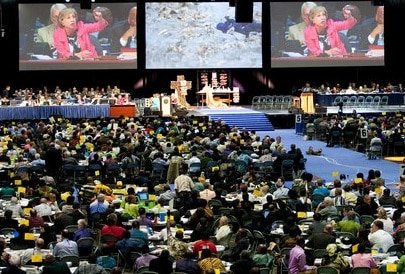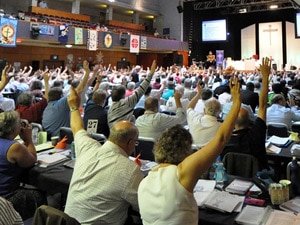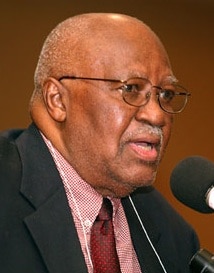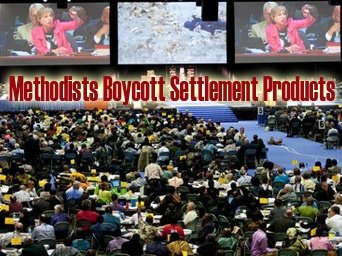 One loss and one victory will prepare the United Methodist Church to take the next step in ending United Methodist support for the occupation. Like the segregated church it was until 1964, the United Methodist church can change.
One loss and one victory will prepare the United Methodist Church to take the next step in ending United Methodist support for the occupation. Like the segregated church it was until 1964, the United Methodist church can change.
By James M Wall
By a vote of 558 to 367, a strong majority of lay and clerical delegates to the United Methodist General Conference called this week for a boycott of Israeli companies operating in Occupied Palestinian Territories (OPT).
The resolution denounces the Israeli occupation and the settlements in a sweeping indictment.
It calls for “all nations to prohibit the import of products made by companies in Israeli settlements on Palestinian land.”
That was not an easy vote. It also was an important victory for anti-occupation forces in Tampa since it calls attention to one of three actions in the growing Boycott, Divestment and Sanctions movement that Palestinians have adopted as a non-violent way to attack the occupation.
The vote on a resolution calling for the UMC to divest its pension funds from three US Corporations, Caterpillar, Hewlett Packard and Motorola Systems, was brought to the floor on Wednesday afternoon.
That resolution was a long shot from the outset. It lost after a series of votes that ended in a final 685 to 246 decision that the UMC would continue to finance the occupation.
One loss and one victory will prepare the United Methodist Church to take the next step in ending United Methodist support for the occupation. Like the segregated church it was until 1964, the United Methodist church can change.
In 1964, a United Methodist layman, W. Astor Kirk, demonstrated how that change can happen. His life story was distributed by United Methodist News Service after his death eight months ago. The full story may be found at the end of this posting.
Kirk and his fellow activists led Methodism out of the darkness of the “go slow” attitude which Martin Luther King, Jr., deplored.
Kirk suffered setbacks in his struggle against segregation within Methodism. Looking back on 1964, after a church union commission voted to continue the segregated conference for African Americans, Kirk wrote:
On the morning of May 5, 1964, when the Church Union Commission made its report … I was completely dumbfounded. My emotions ranged from deep anger to almost uncontrollable outrage to profound sorrow. I could not believe that as late as 1964 … the Church Union Commission would be so ethnically insensitive to the feelings of United Methodist Blacks that it would offer a repetition of the tragic mistake of 1939 [when the denomination adopted a segregated structure].”

This sense of outrage and anger is currently being felt by a new generation of United Methodists activists like Kirk as they proceed in 2012 to win some battles and lose others. They are planning for a long, and ultimately successful battle.
The United Methodist General Board of Church and Society, which Kirk once directed, and which is now under the direction of Dr. Jim Winkler, came to the 2012 Conference armed with resolutions from six different annual conferences. They came prepared.
These UMC anti-occupation leaders coupled a boycott resolution that lacked specificity, with a divestment resolution that named names. They hoped to win on both resolutions, but they knew they could lose one or both.
The boycott resolution passed, while the divestment resolution lost. But the open discussion that followed the introduction of both resolutions exposed the issue to the wider church and to the secular public in ways that Israel does not appreciate.
None of this is really a political debate over money. It is a media war with a moral bite, a public image struggle which Israel is desperate to win and which they most certainly lost in Tampa, in spite of all the spinning by Israel’s US allies.
A boycott is a recommendation to members and churches and a moral call to the larger public. Divestment, even in the comparatively smaller sums involved in the national church’s investment funds, is the greater danger to Israel’s image. Think apartheid and South Africa.
During the heated debate over the UMC pension divestment from three corporations, speakers defending Israel warned that the Methodist church might be subject to law suits for choosing to move funds from one company to another.
That is patently false, of course, but political speeches in secular and religious circles are the same; they are designed to deceive and distort. And Methodists do like to protect the bottom line.
Then there is the matter of finally voting on a resolution. Delegates arrive at the every-four-years gathering after being elected to represent their regional conferences; they sit together under the watchful eye of their presiding bishop, men and women with the power to transfer preachers to larger–or smaller–churches once a year.
Lay delegates also arrive after achieving personal standing in church affairs back home. Unofficial racial and age categories are in play, though unlike the Democratic political conventions, the categories are not mandated.
But these lay delegates do reflect the perspective of the communities where they live. Imagine an attorney from a small Georgia town returning home to tell his clients he just voted to endorse same-sex marriage. You get the picture.
The divestment vote was always a long shot. Consider the regions–annual conferences they are called–that sent the original divestment resolutions to the General Conference: California-Pacific, Minnesota, Northern Illinois, West Ohio, New England, and Baltimore-Washington.
None of these are from what became known after the 2008 General Election as “red states”. They are all from the eastern, mid-western and far western, sections of the country, states that were called “blue states” after the election of Barack Obama.
The United Methodist Church is not a monolithic body. It is a collection of small units of churches, organized by states or sections of states, ruled over by a bishop.
The rest of the assembled 600-plus representatives backed down from supporting a strong resolution that would have divested the church’s pension funds from three US corporations, Caterpillar, Hewlett Packard and Motorola Systems, each of which is deeply involved in supporting Israel’s occupation of the West Bank, Gaza and Jerusalem.
That resolution failed after an afternoon of heated passionate speeches, and a set of parliamentary maneuvers that never gained more than 372 votes from the almost 1,000 delegates present.
By a resounding victory of 685 to 286, the Conference endorsed the UMC’s financial committee resolution which was the final shameful expression by the heirs of John Wesley that wanted to continue to embrace Israel’s theft of the land promised them back in the dim days of biblical history.
I checked with several attorneys. They assured me that there is not a court of law in the United States that would honor a biblical promise as a legal claim. But there they were, the occasional UMC delegate, embracing that concept and voting against divestment.
Of course, not every vote against divestment came from biblical literalists. But at least one literalist got on to the floor during the debate and embraced the promise as a reason to support the occupation.
Wednesday would have been a dark day for Methodism, except for the smart move by anti-occupation delegates to add a boycott resolution to the Conference docket. The side favoring the end of occupation won one, a step forward in what is still a long journey.
Organized religion is, by definition, slow, cautious and distressingly slow. Consider the Catholic Church, still ruled by a Pope in Rome, with rules that bar female clergy and beliefs that are far behind progressive views of human sexuality.
But as this General Conference proved, progress is possible, even in slow-moving established church bodies. Eight years ago the occupation would not have been part of the floor debate. And eight years ago, resolutions counter to the conventional and cautious attitude toward Israel would have been relegated to the final hours of the Conference where time demands would have rushed through meaningless substitute resolutions.
In 2012, a boycott resolution prevailed. A small number of church leaders and conference lay and clerical delegates found a far more receptive gathering of 1000 delegates than has ever been the case in previous General Conferences.
This slowly moving decision-making body has begun to listen to those willing to defy the majority.

All of which calls to mind an earlier United Methodist layman, and a friend of mine, W. Astor, “Bill”, Kirk, an African American church leader who made himself a courageous agitator until the Methodists finally broke the shackles of institutional racial segregation.
His story is that of a Methodist hero who saw evil for what it was and would not give up until his church agreed with him.
Bill Kirk was 89 when he died on August 13, 2011. He had served as a director of the public affairs department of the Board of Church and Society of The United Methodist Church from 1961 to 1966 and as the board’s interim top executive in 1987 and 1988.
It is this board, now directed by Jim Winkler, which was a sponsor of the divestment resolution that was presented to the 2012 General Conference just eight months after Kirk died.
In a story prepared for United Methodist News after Kirk’s death , the Rev. Dean Snyder wrote,”Bill Kirk played an historic role in ending institutional segregation in The United Methodist Church.”
Kirk’s story is that of an African-American layman determined to teach and lead his fellow Methodists to understand the evil of racial segregation.
His story, as it is told by Snyder, needs to be read in full as the 2012 United Methodist General Conference adjourns. Keep in mind that the US Supreme Court unanimously declared segregation illegal on May 15, 1954, in Brown vs. the United States.
In 1960, while serving as a professor at Huston-Tillotson College in Austin, Texas, [Kirk] was elected secretary of the Committee of Five, a group established by the Central Jurisdiction of the Methodist Church with a mandate to end racial segregation within the denomination. The Central Jurisdiction was a structure created in 1939 to segregate African-Americans within the Methodist Church.
Overcoming discrimination was a fight he knew well. He had earned a doctorate in political science at The University of Texas at Austin — the university’s first Ph.D. awarded to an African-American.
Kirk wrote numerous papers and studies for the committee analyzing the history of segregation within the denomination and recommending strategies for ending it.
He took a decisive step against institutional racism during a discussion concerning the merger of the Methodist and Evangelical United Brethren denominations at the 1964 General Conference of the Methodist Church.
Kirk, serving as an alternate delegate, moved an amendment to the proposed plan of merger, which included the continuation of the segregated church. Kirk’s amendment asked that “the Central Jurisdiction structure of the Methodist Church not be made a part of the Plan of Merger.”
In his autobiography, Kirk wrote: “On the morning of May 5, 1964, when the Church Union Commission made its report … I was completely dumbfounded. My emotions ranged from deep anger to almost uncontrollable outrage to profound sorrow. I could not believe that as late as 1964 … the Church Union Commission would be so ethnically insensitive to the feelings of United Methodist Blacks that it would offer a repetition of the tragic mistake of 1939.”
After lengthy debate, the motion, known as “The Kirk Amendment,” passed 464 to 362, establishing the denomination’s commitment to end institutional segregation.
After the 1964 General Conference, when the chair of the Committee of Five, the Rev. James S. Thomas, was elected a bishop, Kirk was elected its new chair. As chair of the Committee of Five, he helped negotiate the mergers of the Delaware and North Carolina-Virginia annual conferences of the Central Jurisdiction with overlapping annual conferences.
In 1965 when southern church leaders argued before the denomination’s Judicial Council that Jurisdictional Conferences had the right to preserve segregated conferences within their boundaries, Kirk took a three-month leave of absence from the Board of Church and Society to prepare a brief arguing that the denomination did have the authority to end segregated conferences. In his brief and oral argument, Kirk argued that the issue of segregation had become a “distinctively connectional matter.”
The Council’s 1965 Judicial Decision No. 232 states: “We have no doubt that the creation of a racially inclusive church is now a matter ‘distinctively connectional’.
In due course, a future Judicial Council (the church’s “Supreme Court”) will rule that the “issue of funding the occupation is a distinctively connectional matter.”
Bill Kirk would be pleased.
The picture of W. Astor Kirk, above, is from United Methodist News Service. The picture of the UMC General Conference was taken by Edward Linsmier for the New York Times.
This article was first published on James Wall’s website: Wall Writings.
Editing: Debbie Menon
About the author: James M. Wall is currently a Contributing Editor of The Christian Century magazine, based in Chicago, Illinois. From 1972 through 1999, he was editor and publisher of the Christian Century magazine. He has made more than 20 trips to that region as a journalist, during which he covered such events as Anwar Sadat’s 1977 trip to Jerusalem, and the 2006 Palestinian legislative election. He has interviewed, and written about, journalists, religious leaders, political leaders and private citizens in the region. Jim served for two years on active duty in the US Air Force, and three additional years in the USAF (inactive) reserve. His website: Wall Writings. View all posts by James Wall.
This video is created by Australians for Palestine and Women for Palestine
as an educational tool to help people gain a better understanding of the clear
principles underpinning the Palestinian BDS call and the global Palestinian
Boycott Divestment Sanctions Movement.
ATTENTION READERS
We See The World From All Sides and Want YOU To Be Fully InformedIn fact, intentional disinformation is a disgraceful scourge in media today. So to assuage any possible errant incorrect information posted herein, we strongly encourage you to seek corroboration from other non-VT sources before forming an educated opinion.
About VT - Policies & Disclosures - Comment Policy




